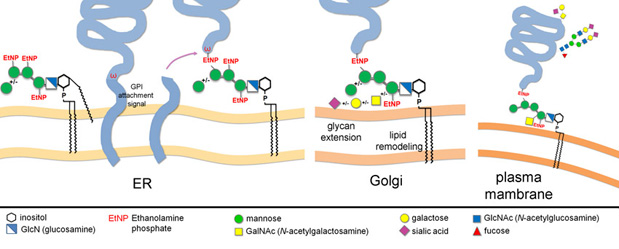Glycolipids
Return to Recombinant Glycoprotein ExpressionGlycolipids comprise another major class of glycans. These molecules are abundant components of the cellular membrane and consist of a lipid moiety attached to monosaccharide or polysaccharide chains that extend into the extracellular space.
- Classes of glycolipids include glyceroglycolipids, lipopolysaccharides, glycosphingolipids, and glycosylphosphatidylinositols (1).
- Glycolipids have varied functions (2,3) some of which include:
- Eliciting host immune responses to bacterial infections
- Modulating cell-cell communication
- Ensuring proper myelination of axons
- One class glycosylphosphatidylinositol anchors (GPI) attach certain proteins to the surface of eukaryotic cells.
- GPI anchored proteins are involved in a variety of cellular processes including cell adhesion and signal transduction.
- GPI anchored proteins also typically possess N- and/or O-linked glycans (Fig. 1).
- GPI anchors appear to be involved in the trafficking and surface localization of a given protein, for instance there seems to be a higher abundance of GPI-anchored proteins in lipid rafts (4).

References:
- Bastow ER, et al. (2008) Cell Mol Life Sci. 65(3):395-413. PMID: 17965830
- Zajonc DM, Kronenberg M. (2009) Immunol Rev. 230(1):188-200. PMID: 19594637
- Stoffel W, Bosio A. (1997) Curr Opin Neurobiol. 7(5):654-61. PMID: 9384539
- Paulick MG, Bertozzi CR. (2008) Biochemistry. 47(27):6991-7000. PMID: 18557633

